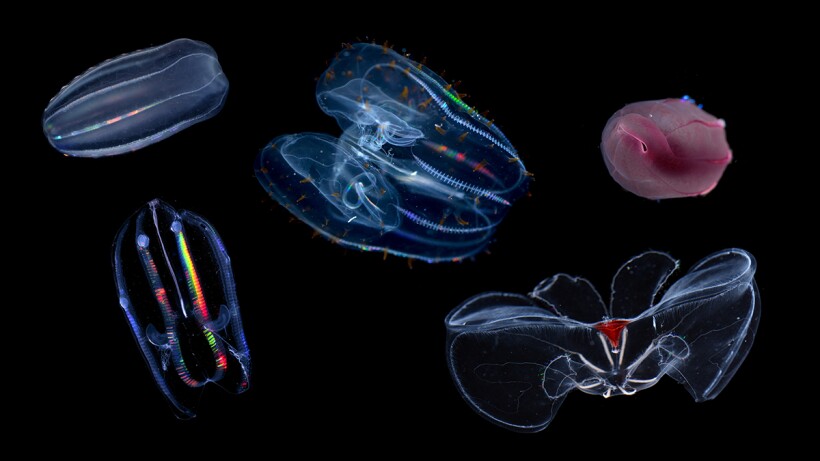Deep-sea comb jellies’ cells are primed to withstand pressure
DOI: 10.1063/pt.uvxq.qukn

Comb jellies, also known as ctenophores, live at various depths and thus at different pressures. To tease out differences between the effects of pressure and temperature, researchers compared ctenophores that live in the shallow, cold waters of the Arctic with those living in similar temperatures deep in the ocean. Photo collage courtesy of Jacob Winnikoff
In the deep, cold waters of Earth’s oceans, some species of comb jellies thrive in the high-pressure environments. At a depth of 4 km, the pressure can reach 400 times as much as that at sea level, yet the jellies are not crushed. Attempts to understand what separates them from surface-dwelling comb jellies have proved difficult. Deep-sea animals often disintegrate when brought to the surface, and some characteristics that would potentially help organisms withstand pressure also could apply to battling the cold.
Now Itay Budin and colleagues in his lab
The researchers used a pressurized sample holder on the Cornell High Energy Synchrotron Source

The lipids in comb jelly membranes naturally exist in a slightly curved state (blue), balanced between stability and flexibility. Lipids from shallow-water comb jellies become straighter when brought deeper into the ocean (lower left). And deep-sea comb jellies have lipids that look exceptionally curved when brought to shallow water (upper right).
Adapted from an illustration by Jacob Winnikoff
The x-ray scattering measurements reveal how the shapes and behavior of the lipids change as the external pressure changes. The authors posit that the ideal lipid shape—slightly conical—is the same across different species of comb jellies in their native environments. Because of that, lipid structure looks different across species when the lipids are all brought to the same pressure. Lipids in deep-sea comb jellies become too conical at low pressures to form flat membranes. Lipids in shallow-water jellies, on the other hand, become cylindrical at high pressures, and membranes are too rigid to undergo dynamic processes, such as division.
Putting their findings to the test, Budin and colleagues introduced deep-sea lipid compounds into bacteria and found that the organisms survived at pressures that would normally kill them. The work helps distinguish between biophysical adaptations that aid survival in cold versus high-pressure environments. The researchers propose that pressure largely influences the shape of lipids in cell membranes, whereas temperature is the dominant factor affecting membrane fluidity. (J. R. Winnikoff et al., Science 384, 1482, 2024